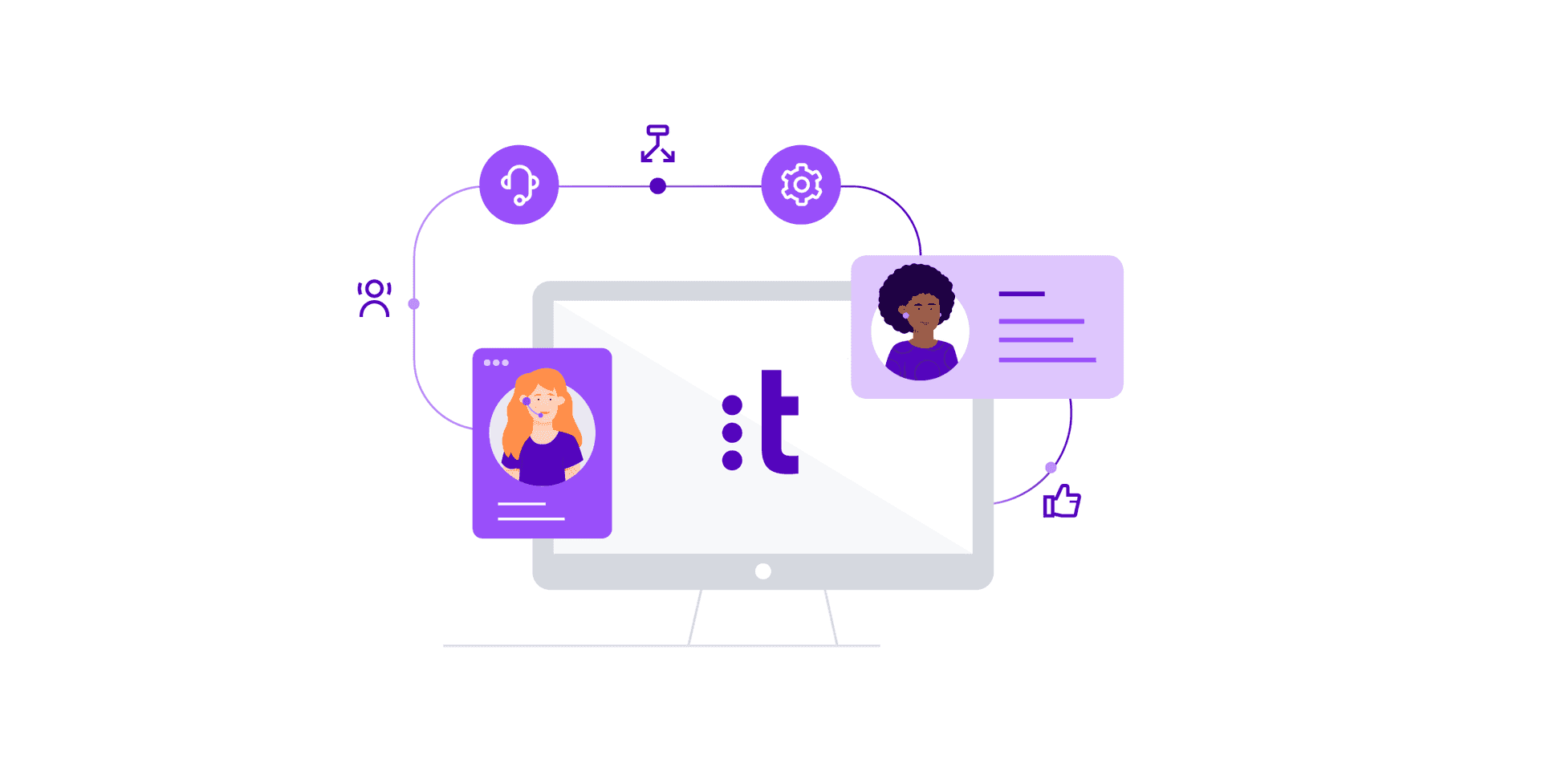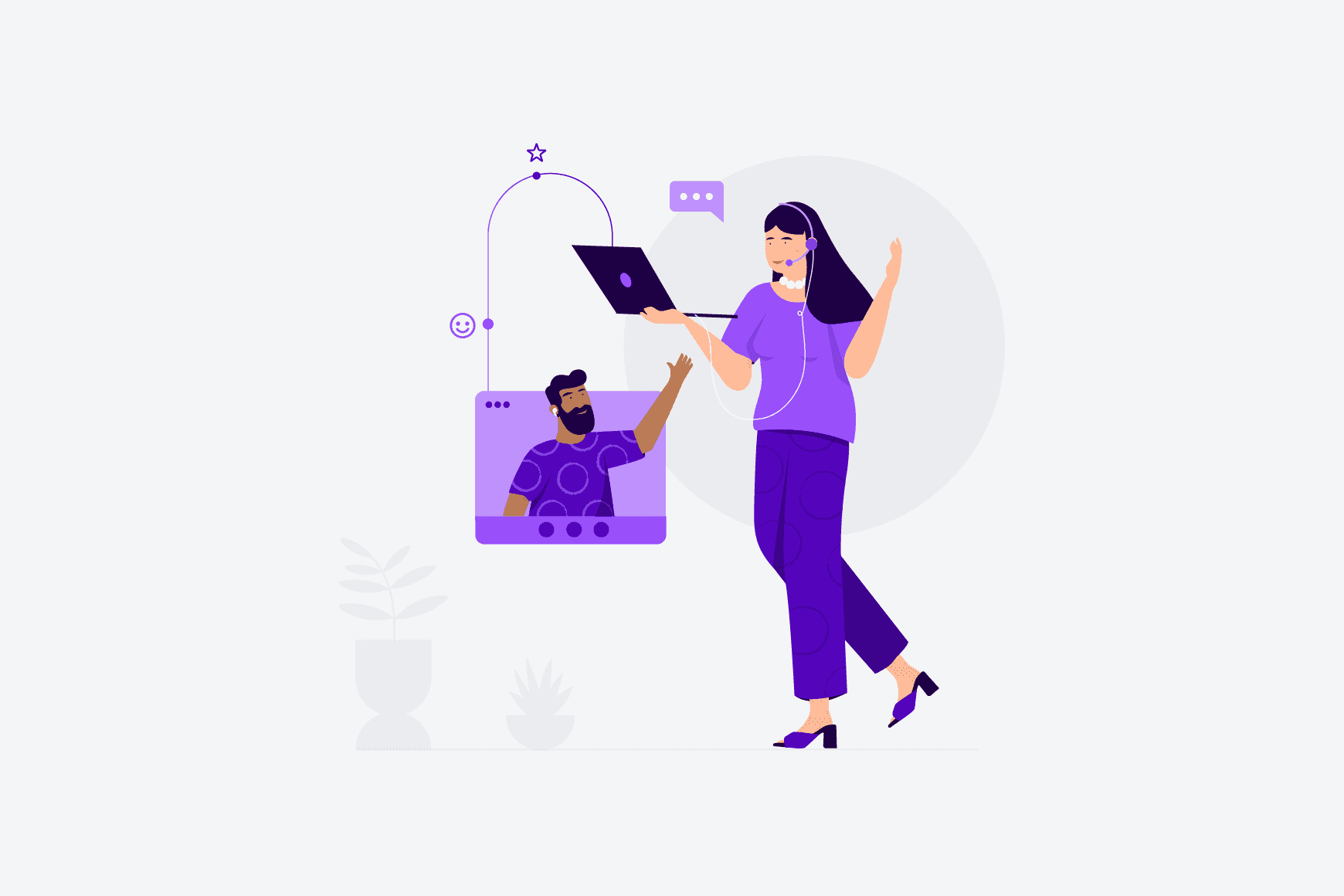5 ways call center technology improves customer service

By Celia Cerdeira
0 min read

The main role of call center technology is to empower agents to resolve customer issues quickly and efficiently.
Providing exceptional customer service is the main goal for contact centers. The best way to provide effective solutions and results is to engage in the most effective communication. With the right tools, it’s possible to improve communication between your agents and the customers who call your business.
Improving communication with customers not only makes the call center job easier for agents, but also has a large impact on customer retention. In fact, According to the Talkdesk Research™ report The future of customer loyalty, 49% of consumers have quit doing business with a company because of an instance of poor customer service. Inconsistency in the service experience is one of the most significant risk areas for companies to lose a relationship and poor communication has a significant negative impact on consumers’ likelihood to work with a company again in the future.
Role of call center technology in customer service.
The right call center technology enables agents to deliver seamless customer experiences through efficient and easy communications.
Customer retention is key to any business because it’s much more expensive to market to a new customer than it is to market to the ones you already have. Plus, loyal customers spend about twice as much as new ones. So, retaining customers through good communication not only saves your company money in the marketing department but also could make your company more money as your retention rates increase.
If you’re looking for ways to improve communication in your call center, it starts with the right tools. Follow these tips and you’re likely to have a much smoother and positive experience for any customer who reaches out to your call center. Here are our five suggestions for ways to improve communication with your customers using call center technology:

Embrace personalization.
Adding a personal touch to each customer interaction will go a long way in terms of improving the overall experience and communication flow for your customers. People respond positively to hearing their name, not having to repeat redundant information, or an agent remembering other details about them. Obviously, these details don’t actually need to be memorized.
By leveraging call center technology that keeps track of everything in your system, from previous orders, chat transcripts, open tickets, and up-to-date contact information, your agents will be well on their way to better communication with your customers.
If agents have all relevant customer information in a single pane, they can quickly understand why the customer is calling—even if the customer isn’t great at communicating their needs— and offer personalized solutions,, providing a unified customer experience that increases resolution time and boosts productivity. Give agents a working application that helps them to build stronger relationships and create upsell and cross-sell opportunities.
In addition to increasing personalization, dropping in those individual details can also help clarify and confirm any issues to improve communication. For example, if you have a customer calling to troubleshoot a technological device, knowing exactly what type of device they have—and all of their previous issues—helps the agent on the other end identify the problem and find a solution faster.
Design smart and effective customer journeys.
There’s nothing quite as annoying as calling a call center, selecting from a choice of departments in their IVR and spending the next half hour bouncing from department to department because no one can help solve the issue. By the time they do get to an agent that can meet their needs, callers are angry, and communication takes a turn for the worse very fast.
Unfortunately, this scenario happens more often than it should. Avoid it by utilizing call center software that has intelligent routing. You can route callers to specific agents based on the geographic location they called from, the department they would like to reach, the agent they are assigned to, the language they speak, or the product they bought
The call center technology considers the team skills and finds the ideal match to seamlessly route customers to the most appropriate agent. If this match happens correctly, not only will customers be more likely to effectively communicate their needs, but the agent will be most capable of meeting their needs. This results in better communication, decreases the likelihood that the agent will transfer the call, and solves the customer’s issue on the first contact—which highly increases customer satisfaction rates.
Empower agents with knowledge.
It always pays to be prepared, and in the contact center knowledge is power. For call centers, this means providing agents with a knowledge base to simplify complex tasks, such as troubleshooting a critical software issue. A knowledge base is a repository of information that helps agents provide consistent and correct answers to customer questions.
Contact center technology that includes a knowledge base eliminates organizational silos by gathering all information in a central place and making it available to agents. Using a knowledge base businesses can:
- Improve efficiency. Agents answer customer issues quickly and on the first contact because they have all information available and easily accessible.
- Reduce errors. A central repository of information enables agents to provide complete and updated information.
- Simplify agent training. Informing agents of the latest updates, features, and company policies requires a lot of time and effort. Knowledge management software simplifies agent onboarding and reduces training times.
- Increase customer satisfaction levels. Providing high-quality information transforms regular calls into exceptional customer experiences, building trust and improving brand loyalty.
- Decreases costs. A knowledge base boosts agent productivity, reduces call times, and leads to faster resolutions.
Call centers can leverage state-of-the-art technology, such as artificial intelligence (AI) to create and AI-powered knowledge base. Benefit from agent assistants that transcribe calls in real time, identifying keywords and pushing the appropriate knowledge base article recommendations to agents, helping them provide answers to customers’ requests faster.
Provide an omnichannel customer experience.
Call centers are no longer only about phone communications. Many companies are now using email, instant messaging, video chat, and various social media channels in addition to the regular phone calls. If your company doesn’t support omnichannel engagement as a contact center technology, you should definitely consider embracing it so that your agents can communicate with customers on the channel that they prefer. Customers also jump between several channels to solve the same issue, for example, they can send an email and an instant message a few hours later. It’s crucial to have a unified view of the customer to ensure a seamless service regardless of the channel.
If your company does use multiple channels, it’s important to make sure that your team is responding to inquiries on every single one. Just because you receive more requests on Twitter than over email, doesn’t mean you should only check your service email once a day. When customers reach out, they expected a response as soon as possible. The fastest way to downgrade your communication is by not communicating at all. An omnichannel solution connects every touchpoint to deliver better customer experiences. For example, agents should be able to view all information about the customer in a single pane to provide a true omnichannel customer experience.
Deploy conversational AI and voice bots.
Conversational AI is transforming the communication between companies and their customers. There’s nothing more frustrating than spending time listening to IVR voice prompts and trying to guess what’s the right option to find an answer. Voice bots enable customers to self-service and get answers to simple questions on their own and at their convenience. Voice bots ensure that support is available 24/7 without the need to add more agents. Plus, they free human agents from repetitive, mechanical tasks and enable them to focus on handling complex customer queries.
Integrating AI into the contact center technology allows for greater personalization. You can understand what is happening during interactions and find out about the root causes of customer issues. What are customers communicating? What channels are they using? Using this knowledge you can proactively make suggestions for new products or services and provide the right answers when they reach out to your business.
Another benefit of adding AI is the ability to easily scale operations. Quickly scale up to meet dynamic campaign needs and seasonal peaks and scale back down with the same speed, agility, and simplicity.
Call center technology FAQ.
What is a call center?
A call center is the main point of contact between customers and the companies they do business with. The call center has large teams of agents that provide assistance on various issues, such ad genereal questions, orders and returns, support service, ans many others.
Call centers can be:
Inbound—agents receive calls from current customers and potential customers.
Outbound—agents make calls to current customers or potential customers.
Blended—agents handle both inbound and outbound calls to current customers and potential customers.
Call centers can be in-house or outsourced to another company.
What is omnichannel?
Omnichannel call center technology allows customers to seamlessly engage with a company through multiple channels and receive the same unified service. It refers to a consistent relationship and preservation of context across all channels and connects the dots between each channel. Customers can start a conversation on any channel anytime, and pick up from where they left off on any other channel at any other time. The ability to move interactions seamlessly from one channel to another while maintaining context is what defines a truly omnichannel customer service experience.
Before you go.
Effective communication and memorable customer experiences are crucial to the success of the contact center. Call center technology is the enabler to continuously improve both. The right platform boosts performance, motivates staff, and provides superior customer service.
Talkdesk CX Cloud offers a full set of enterprise-level, integrated, CX applications for customer self-service, omnichannel engagement, workforce engagement, employee collaboration, and customer experience analytics to align and drive winning behaviors across the organization.
This blog post was originally published in April 2014 and updated in May 2022.







